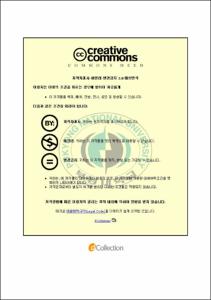교환 상호작용 효과를 위한 자성재료의 합성 및 특성 연구
- Alternative Title
- Study on the Synthesis and Characterization of Magnetic Materials for Exchange-Coupling Effect
- Abstract
- 본 연구는 영구자석용 재료로서 연자성 및 경자성 나노 입자와 이에 따른 합성과 특성연구를 다룬다. 영구자석분야에서 기존의 특성적 한계를 넘어설 수 있는 연/경자성 나노 복합체는 차세대 영구자석 재료로서 각광 받고 있다. 연/경자성 나노 복합체는 연자성과 경자성 입자가 서로의 특성적 한계를 보완해주는 교환 상호 작용 효과를 가지면서 포화자화값 및 잔류자화,최대에너지적이 향상되는 효과를 가진다. 교환 상호 작용 효과를 가지는 연/경자성 나노 복합체를 제조하기 위해서는 연/경자성 나노입자크기가 20 nm 이하가 되어야 하며 연자성의 포화자화값이 경자성의 포화자화값보다 커야 한다. 연/경자성 나노복합체를 제조하기 위해 Chapter 1 에서는 연자성 재료의 합성과 합성된 나노입자의 특성연구를 보고한다. Fe-계 자성 나노입자 및 FeCo 나노입자를 독성이 없고 경제적인 공침법을 이용하여 합성되었다. 합성된 나노입자는 입자의 크기가 20 nm 이하로 제어 되었으며 자성특성이 벌크상 혹은 이론치에 상응하도록 제어 되었다. Chapter 2 에서는 Chapter 1 에서 합성된 연자성 나노 입자와 경자성 재료 Nd₂Fe_(14)B를 고에너지 볼밀법과 공침법을 통하여 교환 상호 작용효과에 대하여 보고한다. 고에너지 볼밀법 및 공침법으로 Fe-계 나노입자와 Nd-Fe-B 합금상을 제조하여 교환상호작용을 이용해 자기적 특성을 향상시킨 Nd₂Fe_(14)B/Fe과 Nd₂Fe_(14)B/FeCo 혼성재료을 제조하여 이들의 자기적 특성과 교환 상호 작용을 연구했다.
In the present study, Fe-based amorphous nanoparticles were obtained by very easy, economical, and nontoxic chemical reduction. The coprecipitation synthesis is a good and easy treatment to get uniform and spherical nanosized particle without component change or other contamination and coprecipitation kinetics is so controlled as to prefer particle nucleation over particle growth, and as to yield ultra fine metallic powder. Moreover the chemical method such as coprecipitation may be used for the large-scale production of ultra-fine amorphous alloy particles. In the point of view, nanocrystallite by the coprecipitation shows excellent soft magnetic behavior, such as high permeability, negligible coercivity, and high saturation magnetization like that of bulk. Exchange-coupling effect was obtained by using these nanoparticles and high energy ball-milled hard phase. In this approach, Nd₂Fe_(14)B/α-Fe, Nd₂Fe_(14)B/FeCo forming core/shell was prepared by high ball mill processing and chemical reduction. In this study, we demonstrate the core/shell type as the interesting one of the various techniques to prepare exchange-coupled spring magnet. A critical factor in achieving spring magnet having exchange coupling effect is that the grain size of soft phase should be smaller than 20 nm, and the interaction between hard magnetic grain and soft magnetic grain can not be obtained in the presence of impurities such as surfactant or stabilizer.
- Issued Date
- 2007
- Awarded Date
- 2007. 2
- Type
- Dissertation
- Publisher
- 부경대학교 대학원
- Alternative Author(s)
- Kim, Chang-Woo
- Affiliation
- 부경대학교 대학원
- Department
- 대학원 화학과
- Advisor
- 강영수
- Table Of Contents
- Background = 1
1. The Chemistry of Nanomaterials = 2
2. Nanostructured Magnetic Materials = 4
3. Chemical Synthesis of Magnetic Nanomaterials = 6
4. Application of Magnetic Nanomaterials = 8
5. Fabrication of Exchange-Coupled Hard/Soft Magnet = 9
6. References = 11
Chapter 1. Synthesis and Characterization of Fe-Based Amorphous Nanoparticle by Coprecipitation = 14
1. Introduction = 14
2. Experimental = 14
3. Results and Discussion = 17
4. Summary = 25
5. References = 26
Chapter 2. A Study of Hard/Soft Magnet for Exchange-Coupling Effect = 27
1. Introduction = 27
2. Experimental = 28
3. Results and Discussion = 32
4. Summary = 35
5. References = 36
Korean Abstract(국문 요약) = 38
Acknowledgment = 39
Epilogue = 40
- Degree
- Master
- Files in This Item:
-
-
Download
 교환 상호작용 효과를 위한 자성재료의 합성 및 특성 연구.pdf
기타 데이터 / 7.88 MB / Adobe PDF
교환 상호작용 효과를 위한 자성재료의 합성 및 특성 연구.pdf
기타 데이터 / 7.88 MB / Adobe PDF
-
Items in Repository are protected by copyright, with all rights reserved, unless otherwise indicated.